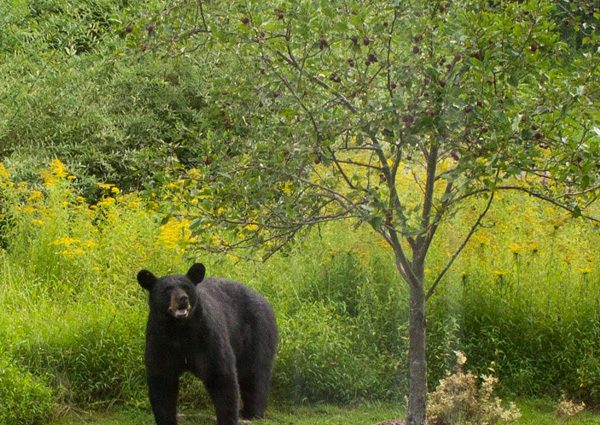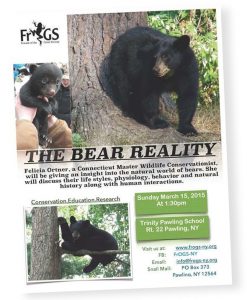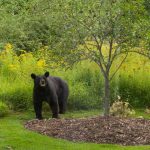designed for the way women work.

Facts You Should Know About Black Bears
Category: Presenting "The Curious Gardener"
Last weekend I learned some interesting things about bears at a talk hosted by a local environmental group called FroGS (Friends of The Great Swamp). The speaker, Felicia Ortner, is a Connecticut Master Wildlife Conservationist, a volunteer outreach program with the Connecticut Department of Energy and Environmental Protection (DEEP).
 Black Bear in my backyard, Pawling, NY
Black Bear in my backyard, Pawling, NY
Where I live in Southern Dutchess County NY, I have seen bears in our back yard twice. The second time was last summer when I walked out on my deck and looked over at a crabapple tree about 20’ away and was startled to see a black bear swatting the branches to eat the little red apples that appear in late summer. After looking at me for a moment the bear got up and walked away, into the woods. I looked out again 10 minutes later and he was back in the same spot. After the second siting, I saw no more of him (or her).
I learned that in the USA there are two types of bears, but in most of the country, including New England, there is only one type, the American black bear. (The other type is the Grizzly Bear, found in northwestern US) New England is currently about 80% forest and with the significant decline in agriculture since the mid 1800’s and the reforestation of the land, black bears have made a substantial return to much of their original range.
Black bears, which are not always black in color, are often shy.
If you encounter a black bear, most of the time you can scare it off by making loud noises. There have been only 66 recorded killings of humans by black bears in North America since the year 1900. Many people have heard that a mother bear will become aggressive if you are between her and her cubs but this is not true for black bears. The cubs are taught at an early age to run and climb a tree to get away from danger, and the mother will do the same. Bears are surprisingly agile and are comfortable climbing trees and can run up to 30 miles per hour, in spite of being pigeon toed and having short legs.
Black bears have a sense of smell that is about 7 times as keen as a dog’s.
And we all know that dogs have a sense of smell that is 1000 times as keen as humans. They are omnivores, meaning they eat both meat and vegetation even though a majority of their diet is vegetation. A bear will be attracted to a home or any area if it smells honey, fruit, garbage of any kind, or bird seed. So the suggestions are that if you have a compost pile do not put fruit or meat in it, if you have a bird feeder take it in at night and put it back out the next morning. (Bears, like many animals, feed at dawn and dusk.) If you have beehives you might need to put an electric fence around them. With pets, to avoid unnecessary problems, keep dogs on a leash or inside if you sense bear activity nearby. A bear may feel threatened by the dog and in the act of defending itself, could cause injury to the dog.
Bears go into hibernation in October or November
When they go into hybernation they find a den or even sleep on the ground without a lot of cover. A mother bear gives birth in January or February, then goes back to sleep, sweeping her cubs up in her arms and pulling them to her body to stay warm and provide food. During hibernation a bear’s body temperature will remain within 12 degrees of their active temperature whereas with ‘true’ hibernators (chipmunks for one) body temperature will go below freezing. A bear’s thick fur helps keep them warm and their body temperature higher. Gradually over the winter they burn through the fat they put on in the summer and fall in preparation for hibernation, and they lose 15 to 30% of their body weight. They come out of hibernation and begin to return to ‘normal’ in March or April.
Bears are solitary animals and adult bears travel alone in their constant pursuit of food.
Mothers give birth in Jan/Feb . Cubs stay with their mothers for about a year and a half and will hibernate with their mothers their first full winter. By the second May or June the cubs are pushed out and on their own so the mother can be independent by breeding season in June and July. Black bears can live to be about 25-30 years old and can weigh up to about 90 to 425 lbs. The oldest known wild black bear died at just under 40 years and the heaviest recorded black bear was 900 pounds.
For more information about bears and other wildlife in your area, contact The Department of Environmental Conservation (or Preservation) in your State.




Living in Pawling too and I saw a black bear last night and again tonight in my yard. (3/22/15). Like you, when it saw me it scampered into the woods. It was nice to see from afar.